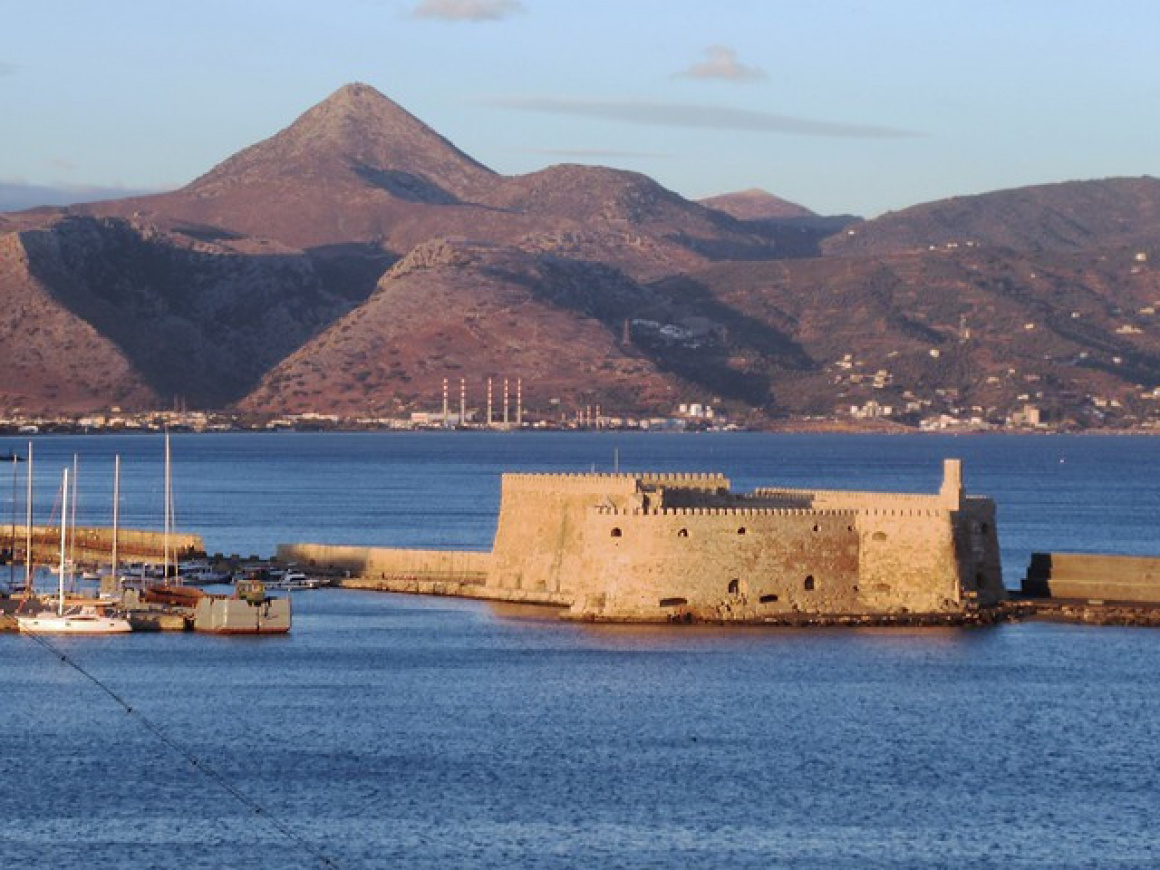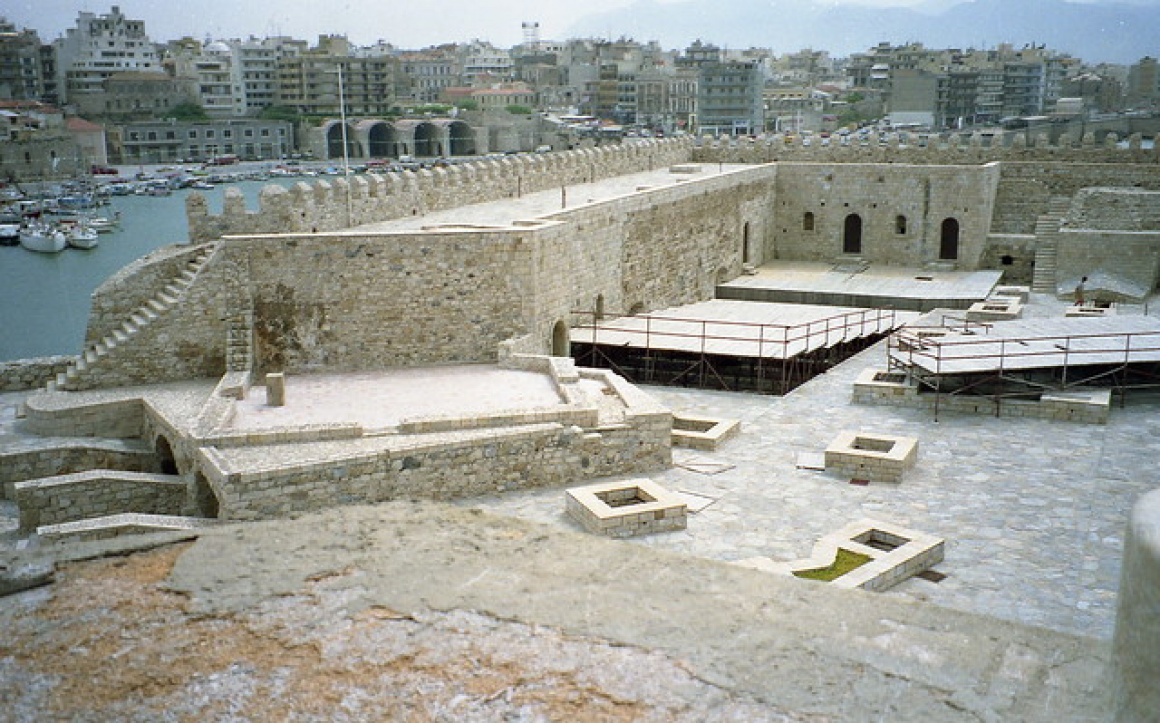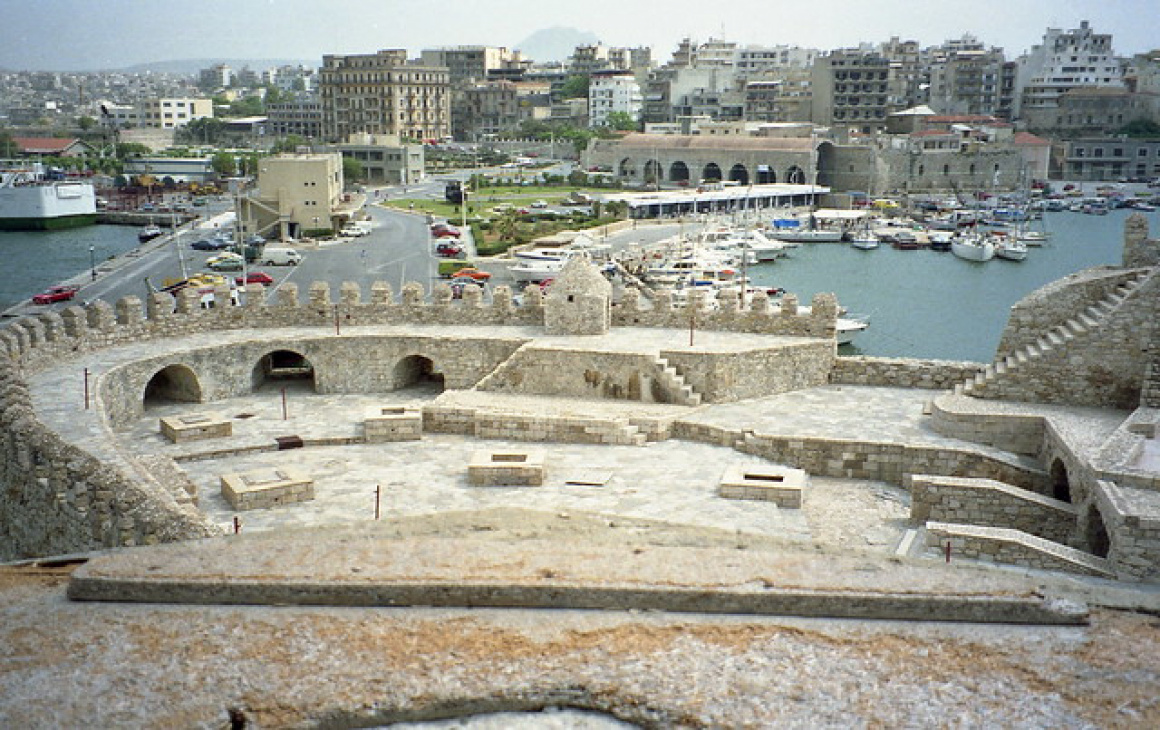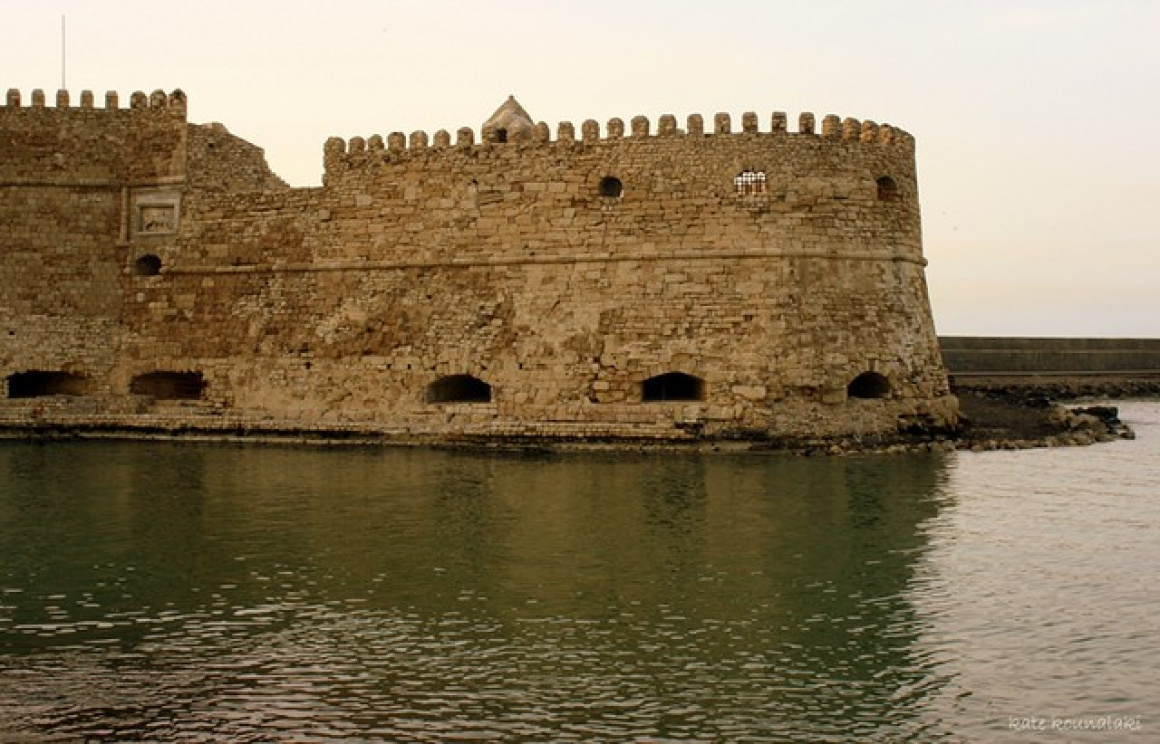At the edge of Heraklion's old harbour, waves crash against mighty stone walls that have stood for five centuries. This is Koules Fortress, the maritime guardian of Heraklion and one of the city's most iconic landmarks. Also known by its Venetian name “Castello a Mare” (Fort on the Sea), Koules commands the harbour entrance with an imposing yet graceful presence. As you walk along the harbour mole towards its hulking silhouette, you can't help but feel transported back to the Age of the Serenissima – the Venetian Republic – when Crete was a strategic gem of their maritime empire. The fortress's massive limestone blocks, ornate reliefs of the Winged Lion of St. Mark on its walls, and the endless blue of the Sea of Crete all combine to create a scene straight out of a history painting. Yet, Koules is not a relic stuck in the past; it's a living monument you can enter and explore, climbing up to its battlements for panoramic views of Heraklion and diving into exhibits that reveal its storied past.

 'Koules Fortress' - Attribution: D-Stanley
'Koules Fortress' - Attribution: D-StanleyVenetian Bastion by the Sea
Koules stands on a site used for fortification since ancient times – the Arabs and Byzantines had small forts here. But the structure we see was built by the Venetians between 1523 and 1540, as part of a grand plan to bolster Candia against the ever-looming Ottoman threat. Approaching Koules, you'll notice it's a two-storey fortress with a squat rectangular outline. The seaward walls are incredibly thick – up to 8-9 metres – designed to absorb cannon fire. At the base, the sea water laps directly, and one can imagine galleys of old mooring alongside. High on the outer walls, three marble reliefs of the Winged Lion of St. Mark (symbol of Venice) gaze proudly. Though weathered, you can still discern the lion holding the gospel – a potent reminder of who built this bastion. One lion plaque bears an inscription with the name of a Doge and the date, commemorating the fortress's completion.
Crossing the bridge over what once was a moat, you pass through Koules' arched entrance. The cool darkness inside contrasts with the bright Cretan sun. Soon your eyes adjust to see 26 vaulted rooms on the ground floor. These chambers, with thick pillars and barrel-vaulted ceilings, once stored food, water, and ammunition for the city during sieges. Some rooms served as barracks for soldiers, others as a prison in later years. Walking through, you might hear echoes of distant footsteps – the acoustics in these stone chambers are striking. The restoration of Koules has turned several rooms into exhibition halls. In one, you'll find displays of cannons, cannonballs, and ancient anchors recovered from the sea, telling of the battles and shipwrecks off Heraklion's coast. Another room might show an audio-visual presentation of the 21-year Siege of Candia (1648-1669), where Koules played a key defensive role until the city fell to the Ottomans.

 'Koules Fortress, Heraklion (150822)' - Attribution: Bob Linsdell
'Koules Fortress, Heraklion (150822)' - Attribution: Bob LinsdellClimbing up a broad stone ramp (historically used to haul cannon to the roof), you reach the top of Koules. The roof is like a broad terrace with rounded corners, where cannons once lined the embrasures. There were originally 18 cannons on the ground floor and 25 on the top ramparts in the 17th century. Today, standing on the ramparts, you have a 360-degree view. To the south, the city of Heraklion stretches out – you can clearly see the old city walls and the mix of modern buildings and historic sites. To the north and east, the endless sea, often dotted with fishing boats or ferries coming into the adjacent modern port. To the west, the curve of the old harbour with its stone arsenals (boathouses) and a long breakwater where locals stroll at sunset. It's one of the best viewpoints in Heraklion, especially enjoyable in the early evening when the stone of Koules glows golden and the city's lights begin to twinkle.
Stories Within the Walls
Every stone in Koules Fortress seems to whisper stories of battles, sieges, and dramas. During Venetian times, Koules not only guarded the port but also served as a symbol of Venetian might. Its presence deterred pirate raids and provided refuge for ships. However, the fortress truly earned its stripes during the epic Siege of Candia, one of the longest sieges in history. For 21 years the Ottomans besieged the city; Koules was bombarded but never taken by force. Ultimately, Heraklion capitulated in 1669 by treaty, and the Ottomans marched in. Under Ottoman rule, the fortress got its current name “Koules” (from Turkish Kule, meaning tower). The Ottomans made some modifications, adding battlements and gun ports on the upper storey. They also built a smaller "Little Koules" on the opposite pier which sadly was demolished in the 1930s.
One of the darkest chapters of Koules was its use as a prison. Many Cretan rebels were imprisoned and died in the damp cells of Koules, especially during the uprisings against Ottoman rule in the 19th century. The most famous prisoner was Daskalogiannis, a Sfakian rebel leader who led a revolt in 1770. Legend has it he was tortured in Koules before being executed in Heraklion's main square. Standing in those lower rooms, you feel the weight of these histories. Today a plaque inside commemorates those who perished in Koules's cells during the struggle for independence. It's poignant to stand where freedom fighters languished, while outside the same walls the sea kept crashing indifferently.
However, not all of Koules' history is grim. The fortress has also been a focal point of community pride. The city has lovingly restored it in recent years (restoration completed around 2016), and now it often hosts art exhibits and cultural events in summer. Locals grow up with Koules as a backdrop – fishermen cast lines off its base, and couples promenade on the pier. It's deeply woven into Heraklion's identity. In 2013, a vibrant art installation lit up the interior, blending modern creativity with ancient stone. And during the summer Heraklion Festival, Koules sometimes becomes an atmospheric venue for concerts or theatre, the audience sitting atop the fortress under the stars as music echoes off its venerable walls.
Visiting Koules Today
Koules Fortress is open to visitors year-round (with shorter hours in winter). As you arrive at the harbour, it's impossible to miss – simply walk the jetty north from the old port's Venetian arsenals. The entrance is on the city side. There's a small fee to enter, but it's well worth it to explore inside and support its maintenance. Plan to spend about an hour or more if you like to linger.
What to See and Do:
- Ground Floor Rooms: Wander through each accessible room. Some have informational panels (in Greek and English) about the fortress's construction, with diagrams showing how old ships were sunk and filled with stone to extend the breakwater platform. Notice details like the holes in the walls for wooden beams that supported multi-level flooring. You can almost imagine the bustle of soldiers loading cannonballs onto carts or the grim silence of captives in a dark corner. One room holds large amphoras and storage jars – these illustrate how provisions were kept.
- Art and Artifacts: Depending on when you visit, you might catch an exhibition. Common displays include model ships, maps of medieval Candia, or recovered antiquities from shipwrecks around Crete. One display shows the evolution of Heraklion's fortifications with Koules as a key node, helping you appreciate its strategic design.
- Climb to the Ramparts: The highlight is emerging onto the roof. Take in the marble relief of the Lion of St. Mark up close above the gate on the inside – one of them still quite defined. Feel the sea breeze on the ramparts. If you look down over the seaward side, you might spot the outlines of submerged breakwaters; the Venetians cleverly created an artificial reef by sinking old ships loaded with stones to form a base for Koules's foundation.
- Photo Ops: Bring a camera or have your phone ready. From atop Koules you can capture postcard-worthy shots: the Venetian harbour with its boat sheds curving below, the modern city and ferries beyond, or simply the textured stone of Koules with the azure sea backdrop. If you're lucky to be there at sunset, the view westwards along the city walls is bathed in warm colours – truly magical and romantic (the locals know this; you'll see many strolling couples around that hour).
- Night Visits: Occasionally, the fortress opens in the evening for special events or extended summer hours. Seeing Koules at night is a different experience – tastefully placed lighting highlights the lion reliefs and contours. The harbour reflecting the fortress lights creates an enchanting atmosphere. Check the local tourism info if any night tours or events coincide with your visit.
- Amenities: There is no café inside, but just outside along the marina you can find plenty of cafes and tavernas where you could grab a coffee or bite either before or after your visit (a popular one literally has outdoor seating with Koules in view). Restrooms are available inside the fortress for visitors. The interior is mostly accessible, though wheelchair access to the top might be limited due to the ramp incline.
- One small tip: The stone floors can be uneven, so wear comfortable, flat shoes. Also, on hot summer days, the stone can get quite warm; a hat and water bottle are advisable though the sea breeze often moderates the heat.

 'Koules Fortress, Heraklion (150823)' - Attribution: Bob Linsdell
'Koules Fortress, Heraklion (150823)' - Attribution: Bob LinsdellConnecting with Heraklion's Heart
Koules Fortress isn't just a standalone sight; it's part of Heraklion's continuum of history that you can trace throughout the city. After exploring Koules, you might walk along the old city walls eastward to St. Peter’s Bastion, or visit the nearby Historical Museum of Crete (which exhibits, among many things, artifacts and stories from Ottoman Crete, giving context to Koules's later years). Even the famous Heraklion Archaeological Museum has objects indirectly connected – for instance, coins and trade goods that would have passed under Koules's watch when arriving by ship in the Venetian era.
A fun connection: while on Koules's roof, look down to the 18 Englishmen Square just at the end of the breakwater. Today it's lined with seafood taverns. It's named after a group of British sailors (“the 18 Englishmen”) who helped operate a cannon there during the 1866 Cretan revolt. Dining there on fresh grilled fish with the looming fortress behind you is a delightful way to round out your Koules visit – a blend of past and present Cretan life.
Koules has gone from a symbol of foreign dominion to a beloved emblem of the city of Heraklion. As you depart, perhaps walking along the harbour mole one more time, take one last look back. The fortress stands robust and eternal, waves breaking at its feet. It has seen conquerors come and go, and now watches over free Heraklion, its dungeons empty and its cannons silent. In that silence, if you listen, the stories still speak – of Venetian captains and Ottoman pashas, of prisoners turned heroes, of merchants and fishermen. Koules Fortress is not just a monument you see; it's one you feel, connecting you intimately with five centuries of Crete's history.


